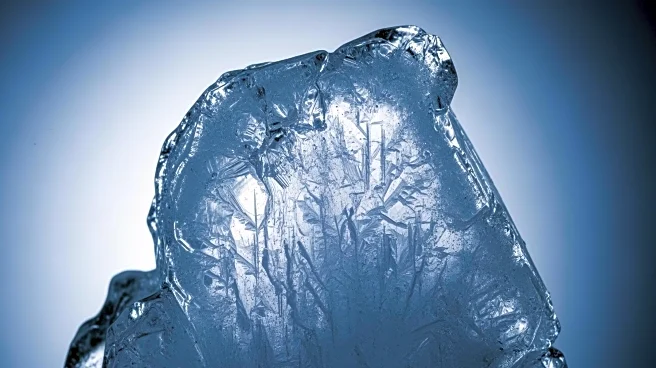What's Happening?
Scientists at the Korea Research Institute of Standards and Science (KRISS) have discovered a new phase of ice, named Ice XXI, through a study published in Nature Materials. This discovery was made by
supercompressing water to 2 gigapascals using diamond anvil cells, a device commonly used in materials science. The process involved subjecting water to immense pressure in just 10 milliseconds, followed by visualization using advanced X-ray facilities like the European X-Ray Free-Electron Laser Facility and PETRA III. Ice XXI is characterized as 'supercompressed' and metastable, meaning it remains stable for a time even when other forms of ice would be more stable. This new phase of ice forms at room temperature due to the high pressure, resulting in densely packed molecules. The research aims to provide insights into the composition of icy moons in the Solar System, potentially offering new understanding of their interiors.
Why It's Important?
The discovery of Ice XXI is significant as it could enhance our understanding of the physical properties of ice under extreme conditions, which is crucial for planetary science. This research may offer new insights into the composition and behavior of icy moons, such as those orbiting Jupiter and Saturn, which are believed to have subsurface oceans. Understanding these ice phases could also inform studies on the unusual magnetic fields of planets like Neptune and Uranus, where similar ice phases might exist. The findings could have broader implications for space exploration and the study of extraterrestrial environments, potentially aiding in the search for life beyond Earth.
What's Next?
Future research may focus on exploring additional high-temperature metastable ice phases and their transition pathways. Scientists could conduct further experiments to understand the molecular structure and behavior of these ice phases under varying conditions. This could lead to new discoveries about the physical properties of ice and its role in planetary systems. The study may also prompt collaborations between international research institutions to expand the understanding of ice phases and their implications for space exploration.
Beyond the Headlines
The discovery of Ice XXI highlights the importance of advanced materials science techniques in understanding natural phenomena. The use of diamond anvil cells and high-tech X-ray facilities demonstrates the potential of these tools in revealing the molecular structure of materials under extreme conditions. This research underscores the interconnectedness of Earth sciences and planetary exploration, suggesting that understanding ice on Earth can provide valuable insights into the cosmos.












